The 1967 Swedish F3 season
Reine & Ronnie: The Swedish golden boys' first duel
Author
- Lorenzo Baer
Date
- January 14, 2024
Related articles
- Ronnie Peterson - Super Swede, by Rainer Nyberg/Mattijs Diepraam
- Reine Wisell - The Sideburn Swede, by Leif Snellman/Rainer Nyberg/Mattijs Diepraam
Who?Reine Wisell What?Brabham-Cosworth BT18 Where?Knutstorp When?III Knutstorp Cup (August 27, 1967 |
 |
Why?
When we think about car racing in Sweden, the first thing that comes to mind may be the country's tradition in rally, mainly due to names like Stig Blomqvist, Harry Källström, Erik Carlsson and Ewy Rosqvist. But it wasn't just on the gravel and ice tracks that the Nordic country left its marks.
Perhaps one of the most lasting legacies of motorsport in Sweden was the one left by the drivers of the country's golden generation, whose greatest reign was Sweden's asphalt circuits. The crop of drivers that emerged at the end of the sixties was undoubtedly essential for the development of this discipline which deviated from the traditional DNA of the Swedes.
Names like Reine Wisell, Ronnie Peterson and Ulf Svensson quickly became known not only in Sweden, climbing their steps in the most prestigious categories of world motorsport. But every story has a beginning. And do you know what was the common element in all of them? The 1967 Swedish F3 season.
An introduction to F3
The history of Formula 3 in the Nordic country begins with the restructuring of the category itself, after the decision made by the FIA of reintroducing the low-level formulae in both national and international scenarios. The original F3 was officially abolished in 1960, due to the disproportionate cost-benefit ratio it offered compared to other classes; in particular, Formula Junior, which quickly became a 'favourite' due to its accessibility, simplicity and competitiveness.
Therefore, it didn't take long for a large migration flow to FJ to materialise, leaving F3 without its main product: beginners and amateur drivers. Without interest from both the public and sponsors, F3 was simply supplanted by Formula Junior, which quickly assumed the role of the 'grassroots' of the world motorsport.
But as meteoric as its rise was, Formula Junior went into decline due to the same factors that had condemned the original incarnation of F3 – costs began to increase, scaring away those who formed the backbone of the racing grids: newcomers, adventurers and those who were just there for fun. Predicting an imminent collapse in the F1 access category, the FIA took a drastic decision: decreeing the end of Formula Junior at the end of 1963, and reestablishing both F2 (which had also been absorbed by FJ) and F3 for the following season, 1964.
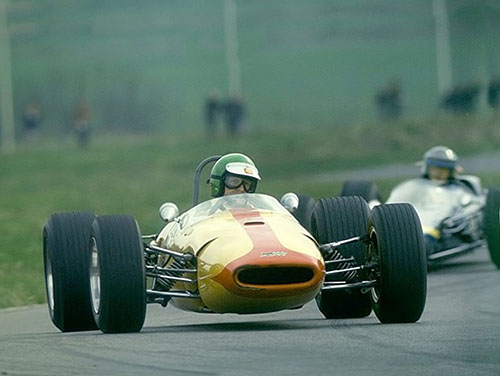
Reine Wisell in his yellow and red Brabham BT18. Shell's main sponsorship was the responsible for the car's peculiar colour in the season. (credits Bilsportarvets arkiv)
As incredible as it may seem, the change went smoothly, without major problems or disagreements. In the case of Formula 3, many of the cars that raced in FJ in previous years were accepted to participate in the races, mainly in the first transition years (1964-'65). This helped substantially to flesh out the grids in these first years, demonstrating that the 'new' F3 would continue to follow some of the guidelines implemented by FJ, such as accessibility and greater flexibility of ideals.
Another feature of this new era of F3 was that only amateur and semi-professional drivers were allowed to participate in the races. This became one of the pillars of F3, as a way of curbing the unfair competition that began to exist in the last phase of Formula Junior. On the other hand, this measure also had economic purposes, as a means of preventing large teams from pouring a disproportionate amount of money, something that was against the new Formula 3 standards.
Leaving the inter-governmental sphere of the FIA, it was now up to F3 to permeate the structures of national motorsport federations - those were to be the main responsibles for placing the category on their official calendars. And again, taking advantage of the legacy left by Formula Junior, many of the events originally scheduled for the category were almost 'recycled', replacing one category with another. With the exception of Italy, which at least initially tried to resist this movement (for obvious reasons, as it was the original birthplace of the FJ), the year of 1964 saw a reasonable number of European federations adopting Formula 3 in their calendars: England (with both the Express & Star BARC British Championship and the BRSCC 500 Club British Championship), France (Championnat de France) and Belgium (Championnat de Belgique) were some of these.
The Nordic countries were not left behind, mainly due to the increasing popularity of closed-circuit racing in the region. The Danske F3-Mesterskabet was established as the official championship for F3 cars in Denmark, while the Svenska F3-Mästerskapet was the Swedish answer to the FIA's request. The last one has certainly become the most popular, due to the good level of competitiveness, in addition to becoming the first experience for many 'soon to be' world-class drivers.
Setting the scene for the 1967 Swedish F3 season
As in other countries, Formula 3 was reintroduced in Sweden in 1964, seeking the country's equivalence with the new standards established by the FIA. This was largely due to the country's established popularity on the international automobile circuit, with races that attracted good names from different categories. For example, the case of the Kanonloppet held at the Karlskoga circuit, which was a non-championship race that featured drivers of the calibre of Jack Brabham, Jim Clark, Dennis Hulme and the most prominent Swedish driver of the time, Jo Bonnier.
Therefore, to create additional attractions for the international events, Formula 3 found its place in Swedish motorsport. The Svenska F3-Mästerskapet was to be contested mainly through 'loppets', with the Swedish word 'lopp' being roughly translated to English as 'race' and the suffix '-et' as 'the'. So, for example, Velodromloppet means 'the race in the Velodrome' or Västkustloppet, meaning 'the West Coast race'. But there were some exceptions to this rule, like the SM för Bilar and the Vårtävlingen. (P.S.: in the text, the reader will be able to see that all loppets will be indicated with the article the, i.e. the Kanonloppet. Although this means duplicating the article - in English and Swedish, because of the '-et' suffix - this system will be used to appear more palatable to the English reader).
The debut season of the Svenska F3-Mästerskapet in '64 gave the first sign of the competitiveness that would mark the championship in the following seasons: Sven Mattsson, in a Lotus-Ford 22, won the overall title with a difference of just 1 point over Freddy Kottulinsky, in a Lola-Ford Mk5.
On the other hand, 1965 was an atypical year, with Picko Troberg sweeping the season and winning the title with a good margin against the competition. Next year, 1966, was the year of Freddy Kottulinsky's redemption after his runner-up spot of '64. The driver achieved four victories in seven valid races of the season, thus guaranteeing three different winners in the three editions of Swedish F3.
There was a huge expectation that this trend would be repeated in 1967, due to the increasingly higher standards of quality in the championship. And this could be summarised in two names that would give a lot to talk about in the following decade: Reine Wisell and Ronnie Peterson.

During SM för Bilar, the most iconic photo of Swedish F3 was taken. Reine Wisell and Ronnie Peterson side by side in one of the corners of the Dalsland circuit. (credits Bilsportarvets arkiv)
Reine had already made his calling card in the 1966 Svenska F3-Mästerskapet season, taking victory in the sixth stage of the season (SM för Bilar, at Dalsland Ring) and finishing the championship in eighth position overall. Due to this and other good appearances throughout the 1966 season, it was expected that the driver from the small town of Motala in the northwest of Sweden would be one of the great contenders for the 1967 title.
On the other hand, a young Ronnie Peterson still lacked real experience in single-seater race cars, having spent much of his career in karts. The driver's official debut also took place in 1966, more specifically in the I Bengtsforsloppet non-championship race at Dalsland where Peterson finished a great third.
But this was the driver's only good result in the 1966 Swedish F3 season. Furthermore, a continuous series of problems with his Swebe (which was nothing more than an underpowered copy of the Brabham BT18) affected Ronnie's performance in the following races.
But the championship wasn't all about the duel between rising stars Reine and Ronnie. Other good names would be present on the Scandinavian circuits: Ulf Svensson, who would actively participate in European F3 races in the early seventies, was one of them. Freddy Kottulinsky, who wanted to be the first two-time Swedish F3 champion, was another. A great spectacle was promised and, certainly, it would not be the drivers who would disappoint.
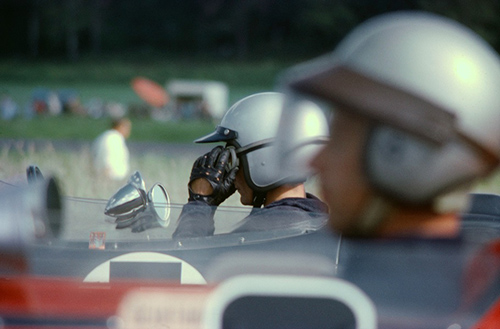
SM för Bilar (Rd 5). In the foreground, Ulf Svensson. The pilot in the background is probably Jean Johansson. (credits Bilsportarvets arkiv)
And having a clear idea about the product it had in hands, the Swedish motorsport federation (Svenska Bilsportförbundet or simply, SBF) actively contributed to making 1967 the best F3 season in the country to date. The season would have the same number of races as in 1966, with a total of ten: seven would be point-scoring races, with the results counting towards the general classification of the Svenska F3-Mästerskapet; the other three would be 'extra events' classified as non-championship races. For the matters of ranking, only the four best results achieved in the point-scoring races would count for the final standings of the championship.
The biggest difference between the 1966 and the 1967 calendars was the Kanonloppet, one of the most traditional events on the Swedish motorsport calendar. Even though the race was, for a few years now, a non-championship race, this event was well attended by many international drivers, most of whom competed in F1 and/or F2. Therefore, after the creation of the Swedish F3 championship in 1964, the addition of this race to the calendar seemed obvious – it was thought that the prestige arising from Kanonloppet would be beneficial to the development of the category as a whole.
The issue is that the foreign competitors swept all the editions of the Kanonloppet, with it being largely dominated by teams and drivers from outside Sweden. Furthermore, the Kanonloppet has always been an event with a different status, a special case compared to the other races of the championship. In the end, it was decided to separate this race from the regular F3 season, being replaced for 1967 by a second race at Skarpnäck.
Even with this change, the robust number of ten events would continue to be enough to maintain a regular calendar, which would be developed between the months of April through September. Therefore, the season was sealed, with the drivers and teams ready to go. Now was the moment of truth for the contenders for the 1967 Svenska F3-Mästerskapet title.
The championship
RACE 1
Ring Knutstorp, Sweden
IV Hyllingeloppet (April 30th)
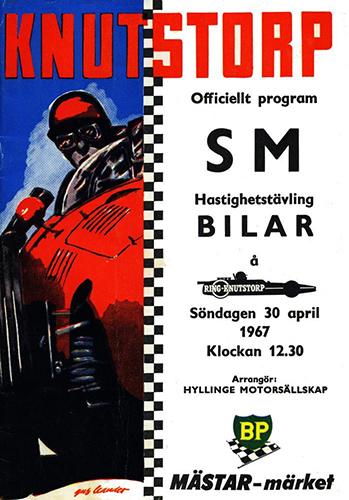
The first race of the season was scheduled for the small Knutstorp Ring, located in the town of Kågeröd. At the time, the circuit layout was only 1,100 meters long (that is, much less than the 2,079 meters of the current circuit), but this did not mean an easy task for the drivers. On the contrary, Knutstorp has always been recognised as one of the most challenging tracks in the Swedish championship, due to the unevenness of the track and its very tight curves.
As expected at the start of the season, many novelties were present on the grid: intending to defend his title by all means, Freddy Kottulinsky had replaced his winning Lotus 35 with a new Lotus 41C. The 41 model, which had originally been presented to the public in 1966, had been the car that finally began to break the hegemony of Brabhams and Matras on the F3 scene – therefore, it was the state-of-art machine for any title contender.
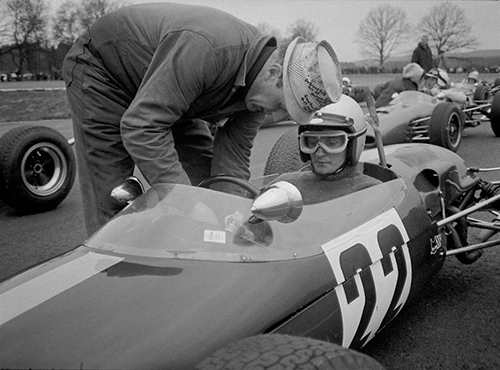
IV Hyllingeloppet (Rd 1). Jean Johansson, Brabham BT16, Ring Knutstorp. (credits Racepace)
Reine Wisell was another one who bet on a new machine for the season. Replacing his venerable Cooper T76 with a Brabham BT18 was a huge leap forward, one that would certainly provide the missing piece for the driver to become a challenger in the general classification. As a peculiarity, it is worth mentioning that this Brabham had belonged to Picko Troberg in the 1966 season. But, soon after the 1965 Svenska F3-Mästerskapet champion announced that he would no longer race in the category, the car was announced for sale, being purchased by Wisell himself.
Even though the car was still extremely competitive for the 1967 season, Wisell wanted to make some updates on the machine, adapting the vehicle to his own taste. The most notable of these was undoubtedly the replacement of the Cosworth engine with a Novamotor. Furthermore, the driver had gained another strong ally for the season to come: the Swedish subdivision of Shell would sponsor Wisell throughout the season – which would certainly give an additional boost to the driver's campaign for the title.
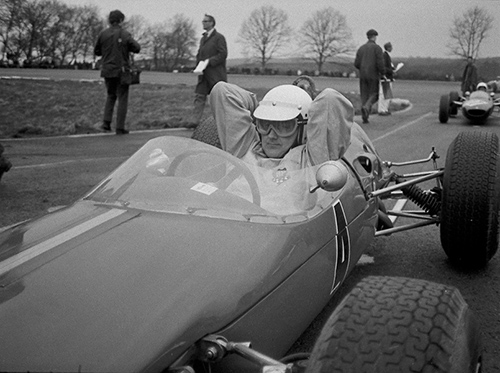
IV Hyllingeloppet (Rd 1). Hans Sjöstedt, Brabham BT16, Ring Knutstorp. (credits Racepace)
Other drivers who stood out in the 1966 championship also presented new features for the race: Ulf Svensson and Lars Lindberg, whom, till now, drove older models from Brabham, each brought a new BT21 to the picturesque circuit, while Egert Haglund who had used a Swebe in the 1966 season now had a genuine Brabham BT18 at his disposal.
Ronnie Peterson, however, still wouldn't show up for the race. One of the pleasant surprises of last season, Ronnie was tied up with his kart commitments, having to compete in a Formula K race in Switzerland on the same weekend as the Knutstorp race. Therefore, only in the next round would the driver be free to drive in Swedish F3.
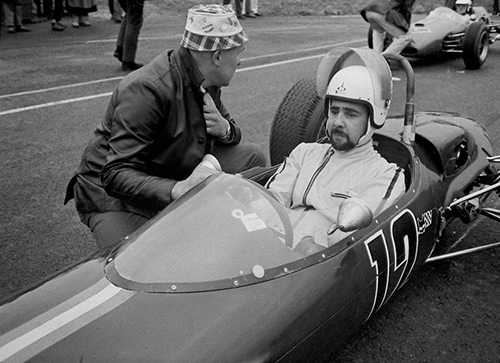
IV Hyllingeloppet (Rd 1). Hans Nilsson, Lotus 41A, Ring Knutstorp. (credits Racepace)
It had been decided that the IV Hyllingeloppet in Knutstorp would have 25 laps. It may seem like an exaggerated number for an F3 race, but it is worth remembering that on a circuit just over 1 km long and where lap times were around 40 seconds, the choice was sensible enough.
Originally, the entry list was released with 27 drivers registered. For the official practice days, however, this number had shrunk to 18, with this being the final tally of participants in the race. Among these, the one who performed best in the qualifying sessions was the reigning champion Freddy Kottulinsky, with a fast lap of 42.1.
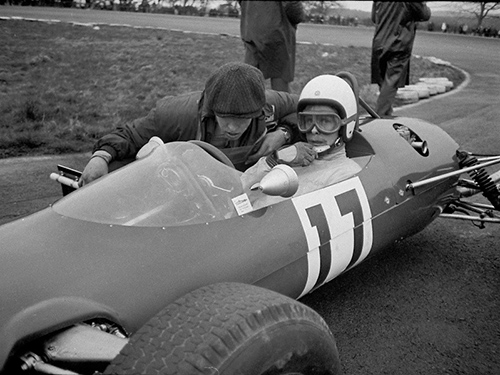
IV Hyllingeloppet (Rd 1). Gunnar Elmgren, Cooper T76, Ring Knutstorp. (credits Racepace)
The following day, more than 25,000 spectators converged on the Knutstorp circuit. In addition to being the premiere of the season, the track, with its countless ups and downs, was an invitation to a huge crowd. Many of the hills adjacent to the track offered almost an unobstructed view of the entire track; hence the popularity of the place with the crowd.
Once the flag had dropped, the race quickly developed into a battle between Kottulinsky and Wisell for first position, with both pulling away from the rest of the field. Right behind, Ulf Svensson secured a comfortable third place. On the other hand, Lars Lindberg in one of the new Brabhams was not so lucky, suffering an accident in the first half of the race.
As the race developed, one of the most characteristic qualities of short circuits began to emerge: slower cars beginning to hinder the faster drivers, making it difficult to maintain a consistent pace. The person who took the most advantage of the traffic was Kottulinsky, who began to open up an advantage over Wisell after the latter got in trouble with lapping some slower cars.
Even with this delay, Wisell tried to answer, setting the best lap of the race with a 45.1. But that wasn't enough, as Freddy Kottulinsky crossed the finish line first, almost 10 seconds ahead of Wisell. Right behind was Ulf Svensson, closing out the podium at IV Hyllingeloppet.
A curious fact is the low number of drivers on the leader's lap at the end of the race: of the 16 cars classified, only five completed the 25 laps. But this was just a secondary circumstance for Kottulinsky who continued his good series of results, a sequence that dated back to the previous season.
RACE 2
Skarpnäcksfältet, Sweden
Skarpnäcksloppet (7th May)
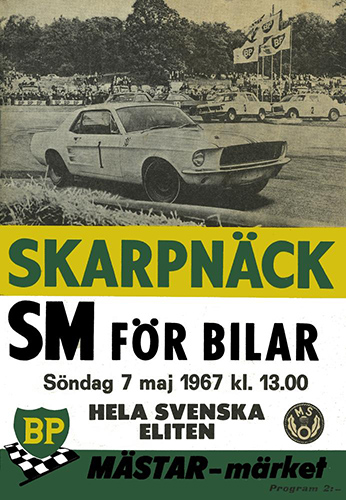
The second race of the season took place a week after the debut in Knutstorp. The setting this time would be the Skarpnäck airfield located in the suburbs of Stockholm. Being a traditional airport circuit, the layout was nothing more than a triangle, cutting off the main runways of the airfield.
The track had already undergone two other layout variations since its foundation (1948), with the third created in 1959 the definitive one for the 1967 race. The loop would be 2200m long, with the start on the eastbound runway; soon after, the drivers would head on to the auxiliary runway, heading south. At the end of the straight, they would make a 180° turn, now heading north to access a taxiway that cut perpendicular to the aerodrome. One more curve and the drivers were back on the starting straight.
For this race, more than 30 drivers had shown interest and signed up for the pre-entry list. Of these, 22 actually arrived in time to take part in the timing sessions – and one of them was a young Ronnie Peterson.
After his obligations with Formula K ended, the driver was ready to make his full commitment to Formula 3. The driver decided to definitively leave aside his old Swebe, which he had had as a reserve car in the 1966 season, to focus entirely on the development of his private Brabham BT18. Even if the British manufacturer's car underwent a cosmetic change for the 1967 season (changing the white colour for a very dark blue), this could not hide the war marks of the car, whose original owner was Kurt Ahrens.
Driven by the German in the 1966 F2 European Championship, the car had been purchased by the Swede shortly after the end of the season, after Ahrens had announced his contract with the BMW F2 team for 1967. Apart from the new colours, the only substantial differences between the 1966 and the 1967 BT18 was the adaptation of the vehicle to the F3 regulations. This did not result in any changes to the chassis, but it did mean changing the original Cosworth engine for a smaller capacity one that fitted in the category standards.
Even with this update, Peterson was still far from the level of preparation achieved by the other drivers, especially Kottulinsky, Svensson and Wisell. Once again, the trio dominated the qualifying sessions, demonstrating that they were above the competition, at least during the beginning of the season.
7500 spectators turned out on a dreary Sunday in May to see that race in Skarpnäck, which would be 17 laps long. Going down the main straight of the circuit, 22 cars fought for better positions before the field began to disperse into small groups.
Even with the commitment of some drivers, the contest was practically a repeat of the opening race of the season: first, Freddy Kottulinsky and Reine Wisell tried to dispatch the competition, and then they focused on a duel for the lead. Ulf Svensson, who seemed to have a car fast enough to break him out of the field but not so good at chasing down the leaders, settled for third.
Ronnie Peterson, who had started in the midfield positions, fought through several small skirmishes, managing to climb up to seventh position; but after that the driver was stuck behind Hans Sjöstedt's Brabham BT16.
Meanwhile, the battle for the lead hotted up, with Wisell now having the advantage over Kottulinsky. The current champion put an enormous amount of pressure on the Team Baltzar/Shell driver, but it seemed like nothing would shake Wisell that day. Towards the end, the driver and his Brabham still managed to open a marginal advantage over Kottulinsky's Lotus – something that was welcomed by Wisell, giving him enough comfort to secure the first place until the chequered flag.
Freddy Kottulinsky crossed the same point just over three seconds later, having played all possible cards in his duel with Wisell – not surprisingly, the fastest lap was scored by Kottulinsky himself, at 1.02.5. Right behind was Ulf Svensson, the guy of the 'third places' so far in the season. Rounding out the top-five were Jean Johansson (Brabham/Ford BT16) and Ove Nicklasson (Lotus/Ford 35).
RACE 3 (NC RACE)
Dalsland Ring, Sweden
Vårtävlingen (May 15th)
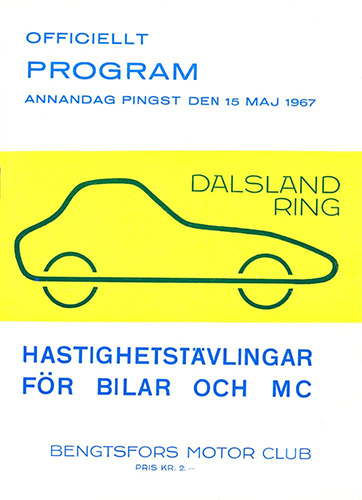
The next stop for the 1967 Svenska F3-Mästerskapet was at the Dalsland circuit, located approximately 150km north of Gothenburg. The race was one of the non-championship events of the season, valid for what was called at the time the Nordic Championship. Putting this dispute into context, the Nordic Championship was an unofficial competition, which involved drivers from countries in the Scandinavian region (Finland, Norway, Denmark and Sweden) in a series of F3 races outside the category's regional championships.
A reasonable number of drivers accepted the invitation to participate in the event, totaling 38 registrations. For the Swedes, who knew that the race did not score points for the overall championship, this was a good opportunity to measure strength with their peers from other countries in the region. On the other hand, for the drivers from Finland and Denmark (Norway did not send any representatives to the race) this was the opportunity to shine in one of the toughest F3 national championships of the world.
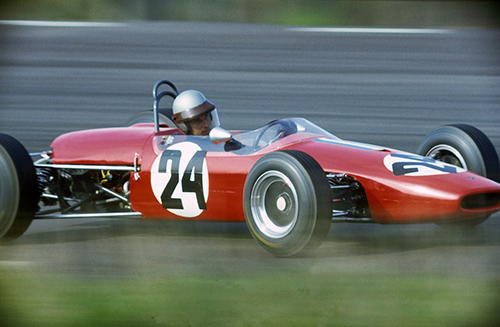
Vårtävlingen (NC Race). Ulf Svensson (#24), Ulf Svensson-Falkenbergs MK, Brabham BT21.
(credits Bilsportarvets arkiv)
The track chosen for the dispute could not be better: Dalsland Ring. The 1650m-long circuit was one of the drivers favorites, due to its fluid and high-speed design. Furthermore, the session between turns 2 and 5 allowed for excellent overtaking opportunities, which were certainly welcomed in F3 racing. In the second half of the sixties, the track was at the height of its popularity, hosting numerous events throughout the year.
The biggest problem with the track for the 1967 edition of Vårtävlingen was that the venue wasn't big enough to accommodate so many entries at once. Originally, it was planned that only 14 cars would compete in the race valid for the trophy, with Swedish drivers being entitled to only nine of these places, as the other five were already reserved for foreign guests.
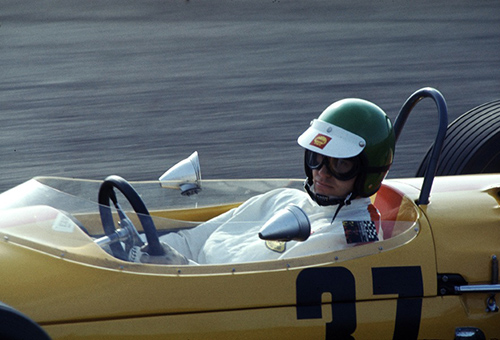
Vårtävlingen (NC Race). Reine Wisell (#37), Team Baltzar Racing Org.-SMK Motala, Brabham BT18.
(credits Bilsportarvets arkiv)
Consulting drivers and teams, the organisers were quick to find a solution for this issue: instead of carrying out a large purge of vehicles, the cars were divided into two groups: those who managed to set the best times would compete in final 'A', which would be the real race for the trophy contenders. A smaller group of ten drivers would run the final 'B' race – this, on the other hand, would be made up of the slowest cars of the timing sessions.
As expected, the drivers who had been dominating the Swedish championship until now qualified easily for the 'A' final. Freddy Kottulinsky, Reine Wisell and Ulf Svensson continued their momentum, but now followed by Lars Lindberg and the increasingly present Ronnie Peterson. While the first managed to break the trio's hegemony, securing the first position on the starting grid of the 'A' final, Peterson would start in a great fifth place, in what was his best qualifying to date in F3.
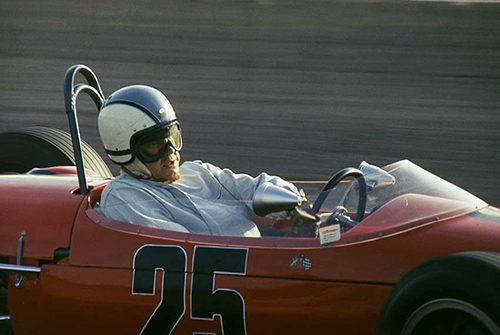
Vårtävlingen (NC Race). Curt-Rune Johansson (#25), Curt-Rune Johansson-Falkenbergs MK, Brabham BT15.
(credits Bilsportarvets arkiv)
The following morning, a beautiful May day emerged on the horizon, as the cars lined up on the grid for the races at Dalsland Ring. Before the big names could step onto the circuit's asphalt, the 'B' race drivers had to open the curtains on the show. In a race that lasted less than 20 laps, it was Börje Sköld who crossed the finish line first, with a Merlyn-Ford Mk10. Right behind, a nice battle for second place unfolded throughout the race, with the Dane Jörgen Ellekaer crossing the finish line two tenths of a second ahead of third place, Jonas Qvarnström.
With the first race over, it was finally time for the 'big boys'. The 'A' final was set to be played over 24 laps, in front of an estimated audience of 14,000 people. Given the start authorisation, Lars Lindberg tried to secure his first position, with a fast Reine Wisell coming close behind. 'Kotten' and his Lotus were satisfied enough with third place after the first corner, with Ulf Svensson and Ronnie Peterson already outlining the lines of a fight.
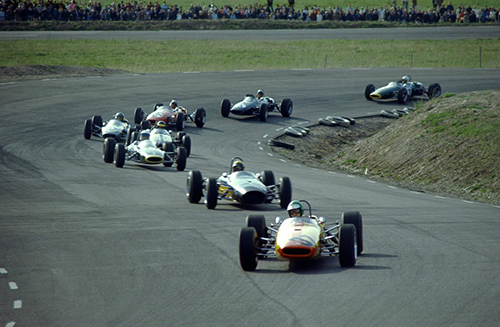
NC race-Vårtävlingen. Reine Wisell leads Lars Lindberg and, Hans Nilsson in the first lap of the race.
(credits Bilsportarvets arkiv)
In the next few laps, Lars Lindberg and Reine Wisell were the ones who carried out the biggest action of the race, with the Team Baltzar driver taking advantage of some of his opponent's mistakes to get closer, and then, get in the strike zone for the lead. Lindberg's resistance was not very stiff and Wisell had no trouble taking the first position.
With this battle solved, the action moved a little further back on the grid, where Svensson and Peterson put on a great show. The more experienced Svensson held back the attacks of the lurking Team Vagabond driver, causing the driver to lose patience at certain critical moments. Without the necessary calm and concentration, nothing Peterson tried would be enough, as Svensson delivered another one of his solid performances.
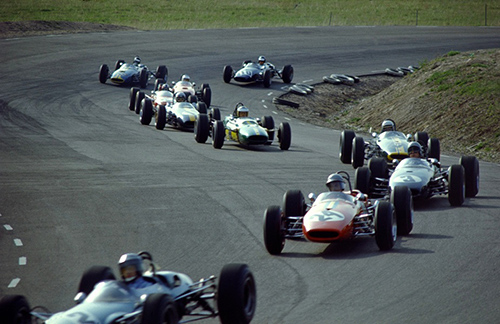
Another pic of the NC race-Vårtävlingen in Dalslands Ring. Now it's the turn of the final part of the pack.
(credits Bilsportarvets arkiv)
The one who thanked this battle was Freddy Kottulinsky, who seemed to be in a race of his own. Unmolested by his pursuers and not wanting to push his car too much, the driver settled for third place until the checkered flag.
But the honours of the day belonged to Reine Wisell, who finished the 24 laps of the race in 18.52.1. A well-deserved first place, which basically established Wisell as one of the favourites for the title in Sweden. Lindberg was also elated, because after his problems in the last races, he finally recovered in this non-championship race. Second place was an excellent result for the driver's confidence in himself and his Brabham BT21.
The last observation worth noting was that Olavi Kuikka was the best of the foreign guests in the main event. The Finn, who drove an old Cooper T65/67 Formula Junior upgraded to F3 specifications, managed to finish the race in 9th, one lap behind the leaders.
RACE 4
Gelleråsen Arena, Sweden
Velodromloppet (May 21st)

Fourth round, fourth different track in the championship. The destination now was the Karlskoga circuit, the longest circuit of the season with 3000m. Also known as Gelleråsen Arena, the venue was at the time the main circuit in the Nordic country, as well as being one of the first and best equipped facilities dedicated solely to motor sport in Sweden.
In the 1967 layout, the track was a great combination of straights of good length, with a tighter infield session. The most recognizable parts of the circuit in this version were Björkdungskurvan, a half-chamber corner just after the start/finish straight; the Velodromkurvan, a low-speed 180° bend, just after the first straight of the Velodrome session; and the Paddock Curve, which the most courageous did at full throttle, to exit with the maximum speed onto the main straight of the circuit.
Once again, the drivers turned out in force to compete in a Svenska F3-Mästerskapet race: 32 entries were received by the organizers, with the detail that only 22 of these would qualify for the weekend's race. So, it's no surprise that practice sessions were particularly close contests, with drivers battling against the clock to stay above the cutoff line.
But in the end, no big surprise. The drivers who dominated the top positions in all the races so far repeated the feat again: Ulf Svensson, with a time of 1.28.3 would be the one who would start this time in the position of honour on the grid, accompanied by Freddy Kottulinsky on the front row. Lars Lindberg seemed to have found his groove with his Brabham, setting the third fastest time; in fourth, an increasingly bold Ronnie Peterson, who seemed to get much more out of his Brabham BT18 than it could actually offer. Only in fifth position would Reine Wisell start, after the driver faced several engine problems in his Brabham, which even forced Wisell to change cylinders after qualifying training.
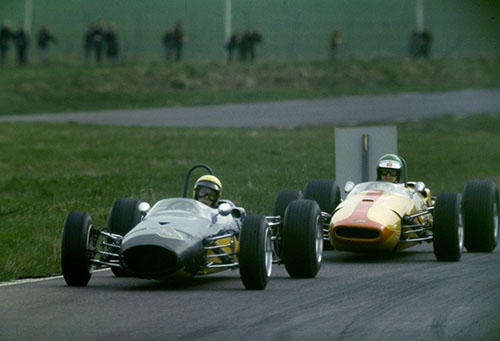
Lars Lindberg fends off the attacks of Reine Wisell during the 1967 Velodromloppet. In the end, the driver gave in to pressure. (credits Bilsportarvets arkiv)
After a sleepless night making the final adjustments, machines and drivers were ready for the third race that would earn points for the champion. Given the start, the drivers immediately turned to their personal strategies: while some aimed to consolidate their positions and then attack, others chose a withering charge right away.
This was the case for Reine Wisell, who in the first lap had already been promoted to fourth place, after starting better than Ronnie Peterson. Further ahead, Ulf tried to stay in first place, something that he achieved during the first six laps; in the seventh, however, his Brabham BT21 failed, due to a problem with the ignition system. It was the end of the race for Svensson.
Therefore, who inherited the first place was Lars Lindberg, with Freddy Kottulinsky right behind. However, Reine Wisell, who was still in third place, seemed to be the one who would pose the greatest threat to Lindberg's lead, as he was approaching at an alarming rate. Because of this, it didn't take long for Wisell to pull over Kottulinsky and overtake him, without “Kotten” offering much resistance.
But part two of Wisell's quest to take the lead would be a little more complicated. Lars Lindberg offered a worthy challenge to Wisell, with the two battling it out for a few laps. The thing is that Wisell began to use one of his greatest strengths against the competition to his advantage, which was his above-average ability. Lindberg could do nothing to make up for this gap and Wisell took advantage of the opportunity as soon as it arose: Team Baltzar's red and yellow Brabham was once again leading a race.
Freddy Kottulinsky, observing Lindberg's moment of weakness and Wisell's lead in the championship, tried to accelerate as much as he could. But this rush proved fatal for the driver: on the 12th lap, when Kottlinsky was getting closer and closer to his opponent, the driver committed a rare mistake, trying to overtake a slower car at Paddock Curve. The latecomer who was the victim of overtaking made an abrupt maneuver at the last moment, causing the two cars to collide and be catapulted to the outside of the curve.
Kottulinsky's car rolled over twice and ended up upside down in a drainage ditch next to the track. Luckily, the driver emerged with only minor bruises from the accident, being quickly taken to the hospital in the city of Karlskoga.
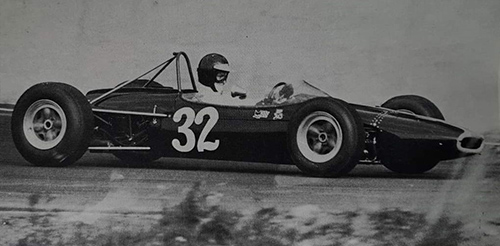
Ronnie Peterson, Team Vagabond Karlskoga MK, Brabham-Cosworth BT18 in the III Knutstorp Cup 1967.
(credits Rickard O. Lindström)
Even with the accident, the race did not stop: in the final laps, Ronnie Peterson, who had inherited third place after Kottulinsky's accident, was overtaken by the surprising Ove Niklasson, in a Lotus 35. Ronnie quickly tried to answer, but Niklasson did better in the final moments of the race, crossing the finish line two tenths of a second ahead of Ronnie. Even so, this was not a bad result for Peterson who, with his fourth place, scored his first three points in the 1967 Svenska F3-Mästerskapet.
But the one who was really elated was Reine Wisell. After a beautiful race, in which the driver fought almost directly with all his main opponents, he was crowned the winner of the Velodromloppet, completing the 16 laps of the race in just over 23 minutes. Furthermore, the driver was now in the isolated lead of the championship, with his closer pursuers, Lars Lindberg (who had finished another race in second place) and Freddy Kottulinsky, eager to overthrow the unstoppable Wisell.
RACE 5
Falmarksbanan, Sweden
III Midnattsolsloppet (June 23rd)
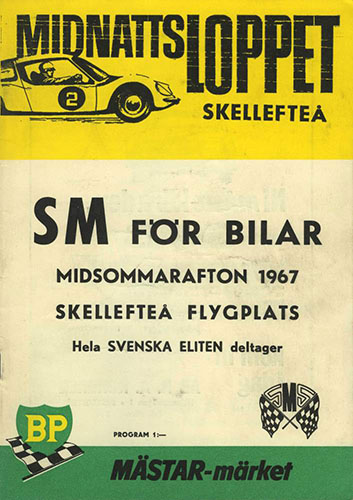
One of Sweden's most traditional hallmarks are its peculiar meteorological and astronomical events. The northern lights, known commonly as the Aurora Borealis, are the phenomena that give the country its identity during the long winter nights; meanwhile, in summer, with much longer days, the sun reigns supreme for almost 24 hours.
In the latter case, the Midnattsolsloppet is included, which in literal translation means the 'midnight sun race'. The event, which was in its third edition in 1967, had already become one of the most peculiar events in world motorsport, as it was held precisely on days when the sun was almost at its peak in the northern hemisphere, providing sunlight deep into the night.
Since the 1965 edition, the race venue has been the city of Skellefteå, in northeastern Sweden. The city was chosen mainly because of two factors, which restricted each other: it was the northernmost place where a race could be held, providing maximum sunlight during the night and early morning, in addition to being basically the only city in the region that could offer a minimum infrastructure to meet the demands of the event.
Part of this infrastructure was represented by Falmark airport, 20 kilometers south of the city Skellefteå. The landing strip was the ideal place to hold a race, due to its leveled floor, the good quality of the asphalt and because it provided enough space for the teams and drivers. Just as a general overview, the runway was just over 2100 meters long, comprising the airport's main takeoff runway, as well as taxi zones and the aircraft maneuvering and parking area.
Due to the long trip, which involved costs for the teams, the entry list was well below the championship average: only 15 drivers would attend the Midnattsolsloppet. As expected, the best drivers had no problems securing the front rows of the starting grid. The surprise came from Freddy Kottulinsky who, with a borrowed Swebe (since the driver's Lotus 41C was in the workshop after his accident in Karlskoga) managed to stay at the same pace as his opponents.
For the midnight sun race, what was really missing was the sun itself. The entire day of the 23rd was marked by constant rain, in addition to sharp gusts of wind. But nothing that would scare the public away, who showed up in reasonable numbers to witness the race (according to reports at the time, more than 12,000 people were in the Falmarksbanan airfield).
After holding several support events (including some touring races) it was F3's turn to shine on the circuit. By the time the cars lined up on the grid, a timid sun had appeared, giving the finishing touch to the event. When the cars crossed the starting straight for the first of the 15 valid laps of the race, it became clear that the main dispute of the race would be between Lars Lindberg and Freddy Kottulinsky.
The two drivers fought side-by-side for the lead of the race, with Kottulinsky having the upper-hand in the first half of the race. Further back, an abnormally calm Reine Wisell just lurked, showing no ambition for a higher position on the podium. Ronnie Peterson was also pleased, accepting fourth place.
The one who once again was below its previous performances was Ulf Svensson, who was during the entire race in the rear of the peloton. The driver had gone downhill in the last few races, more due to chronic problems with his Brabham BT18 than a lack of confidence in himself. By the end of the race, Ulf had dropped to tenth position, one lap behind the leaders.
And speaking of them, as the race approached the final laps, the battle heated up, with Lars Lindberg redoubling his efforts to achieve victory. And the driver waited until the ideal moment to launch his decisive attack: on the penultimate lap, Lars saw a gap left by Kottulinsky when braking in one of the corners and just made a risky move.
Lars let his car slip a little, pushing 'Kotten’s Swebe into the dirtiest part of the track. Even though the maneuver was dangerous, Lars Lindberg managed to reap the rewards of his cunning strategy, now being in first place. And nothing and no one would now take the driver out of first position, with him managing to finish the race in 16.51.3.
Four tenths of a second behind, Freddy Kottulinsky was in a dismal second place, after having led almost the entire race. Rounding out the podium was Reine Wisell, who had done absolutely nothing to enter the fight for victory in the race. Not surprisingly, the driver finished 6 seconds behind Kottulinsky.
Even though he didn't finish in the highest position on the podium, a fact little overlooked in a post-race analysis was that Kottulinsky proved that Swebe's F3 cars were competitive, even though they were treated as inferior vehicles to their imported counterparts. What was always missing was a driver who knew how to make the most of the car's best features – and 'Kotten' was one of the few who managed to do that.
RACE 6
Dalsland Ring, Sweden
SM för Bilar (July 2nd)
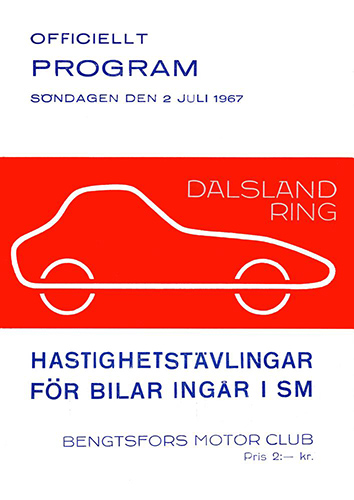
Once the fifth official round of the season arrived, it was time to return to the Dalsland Ring. Reine Wisell led the championship so far, with 23 points. Freddy Kottulinsky, with 17 points, was in second and a reborn Lars Lidberg was already in third place, with 12 points. After the race in Skellefteå, Ulf Svensson had dropped to fourth place, now being threatened by Ronnie Peterson.
Unlike the race at the beginning of May, SM för Bilar was qualified as a valid stage for the Svenska F3-Mästerskapet points. Furthermore, only entries from drivers competing in the Swedish championship were accepted by the organisation. But, as always, that didn't stop the downpour of applications; and in the end, more than 30 vehicles attended the Dalsland circuit.
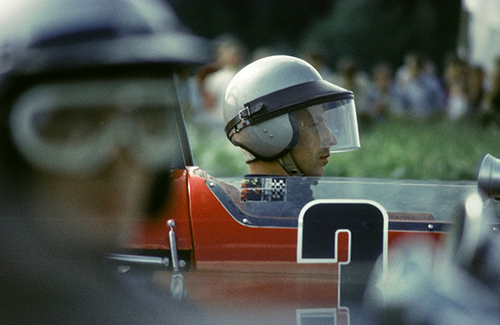
SM för Bilar (Rd 5). Ulf Svensson (#3), Ulf Svensson-Falkenbergs MK, Brabham BT21.
(credits Bilsportarvets arkiv)
Freddy Kottulinsky had his Lotus 41C back, demonstrating right away in practice that his time with Swebe had not changed his driving style in any way. Lars Lindberg continued on an increasingly sharp rise, entering the fight for the championship title for once and for all. But the fastest in training was Reine Wisell, who once again demonstrated that he was the driver to beat.
An audience of more than 15,000 people turned out to watch the race on the cramped circuit on the outskirts of Bengtsfors. Of the 30 cars registered, only the 14 best classifieds had the right to start – and, by the end of the race, only 10 were still running.

SM för Bilar (Rd 5). Reine Wisell, Team Baltzar Racing Organisation, Brabham BT18.
(credits Bilsportarvets arkiv)
But until the chequered flag, a lot happened in the race. Reine started the race in the lead, but it wasn't long before it was stolen by Lars Lindberg. Ronnie Peterson also managed to take advantage of these first moments of the race, overtaking Freddy and Reine on the first lap.
Ulf Svensson, on the other hand, was just a shadow of what he was in the first stages of the championship, holding a precarious fifth position – that's because Ove Nicklasson and Jean Johansson threatened Ulf every moment.
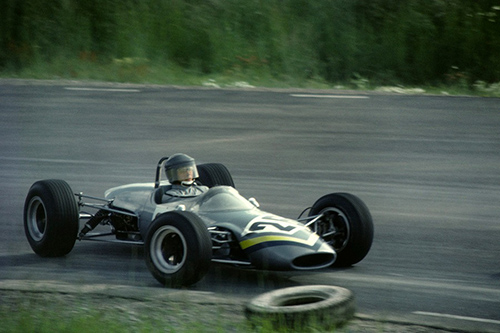
SM för Bilar (Rd 5). Freddy Kottulinsky, Haj-Haj Racing Team-Botkyrka MK, Lotus 41.
(credits Bilsportarvets arkiv)
Returning to the leaders, Lindberg increased his advantage, with Wisell now coming in second place. Peterson, who had started so well, still had problems when faced by his more experienced rivals – but nothing that couldn't be remedied with a little more time in the cockpit. Consequently, the driver ended up giving in not only to pressure from Wisell, but also from Kottulinsky, as the laps went by. The new second and third-placed drivers soon set their immediate goals: it was time to begin the hunt for Lindberg.
The one who was most at ease with his concerns was Svensson, who after the initial threats from Nicklasson and Johansson, now found himself isolated in the middle of the groups. This was due to successive problems for his pursuers.
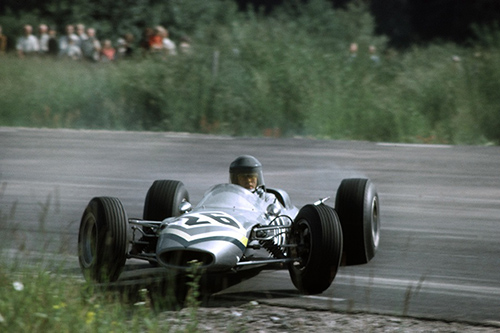
SM för Bilar (Rd 5). Freddy Kottulinsky, Haj-Haj Racing Team-Botkyrka MK, Lotus 41.
(credits Bilsportarvets arkiv)
The first to have complications was Jean Johansson, who shortly after halfway through the race, suffered a breakdown in the steering of his Brabham, with the car hitting the side of the track, overturning during the crash. Fortunately, the driver emerged from the accident unharmed. Soon after, it was Nicklasson's turn, who also had to withdraw due to a mechanical failure.
And it looked like the race really was going to be a test of attrition, even though it was only 20 laps long. With a quarter of the race remaining, Lindberg's engine began to choke, which initially did not bother the driver. The problem is that this soon turned into suspicious smoke coming out of the car's exhaust – synonymous of bigger problems for the driver.
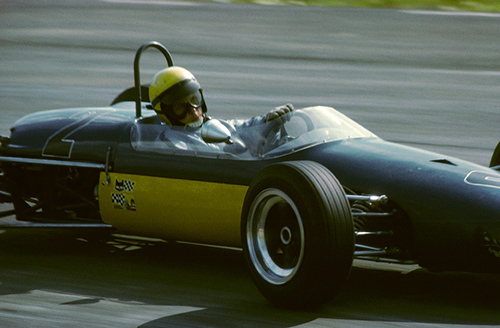
SM för Bilar (Rd. 5) Lars Lindberg, Lars Lindberg Racing-Stockholms BK, Brabham BT21.
(credits Bilsportarvets arkiv)
As the only available measure to take so close to the finish line, Lindberg tried to slow down a little, to take his convalescent car to the chequered flag. The driver's luck was that the advantage he had built over his opponents in the opening laps would be the exact measure to guarantee him victory. Not surprisingly, when Lars Lindberg completed the last lap of the race, Reine almost managed to overtake the driver at the finish line.
By a margin of hundredths, Lars Lindberg was declared the winner of the 1967 SM för Bilar. Reine Wisell finished in a bittersweet second place; and Kottulinsky, in his rebuilt Lotus, in third. Ronnie Peterson was once again one position away from the podium, revalidating the fact that the driver was not a one-hit wonder, but rather, a great promise for the years to come.
RACE 7
Falkenbergs Motorbana, Sweden
XV Västkustloppet (August 6th)
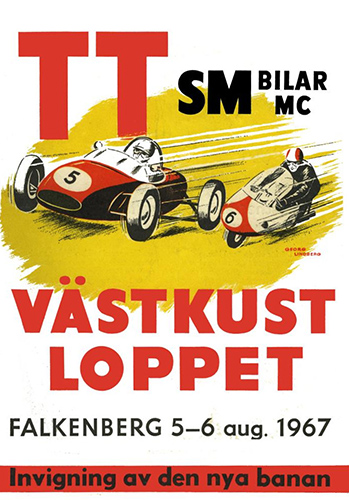
The sixth race of the season (and seventh in total, counting the non-championship race at Dalsland) would be held at the brand new Falkenberg circuit, located in the city of Bergagård. The track was the newest attraction on the Svenska F3-Mästerskapet calendar, and mostly unknown to the Swedish drivers. With the exception of a few F3 drivers who also competed in touring races in the country, the August race would be the first contact for many with the new track.
Until 1965, the Skreabanan street circuit, also located near Bergagård, was the home of the Västkustloppet. But due to the insecurity of the track (which was a simple trapezium made up of public roads) and the increasing speed of the cars, it was decided to build a place dedicated solely to car racing. Not wanting to get rid of the identity and legacy of the old circuit, the location chosen for construction of the new venue was just a few kilometers away from the original route.
With the name Falkenberg Motorbana, the track opened in April '67. It was a modern circuit, with a generous pit area and other amenities that were impossible to develop on a precarious street circuit. Measuring 1833 meters in its original configuration, the circuit soon gained the reputation of being one of the fastest in northern Europe. Most of the bends had a wider radius, and these were interconnected by straights that allowed greater development of the machines' engines.
In addition to the need for updates to conform with the new standards of motorsport safety, another factor that stimulated the construction of the track was the location of the city itself. Bergagård is just over 100 kilometers away from Gothenburg, and 200 kilometers from both Copenhagen and Malmö. Therefore, there was a huge potential audience.
For the first Formula 3 race on the circuit, 20 cars were listed to compete for the trophy. The trio of Reine Wisell, Freddy Kottulinsky and Lars Lindberg, who had stolen the show in the last few races, continued their streak: Lindberg, in a spectacular lap of 44.2, had managed to secure the first position on the grid; Reine, once again, would start in the top three, with Kottulinsky himself as his companion on the second row.
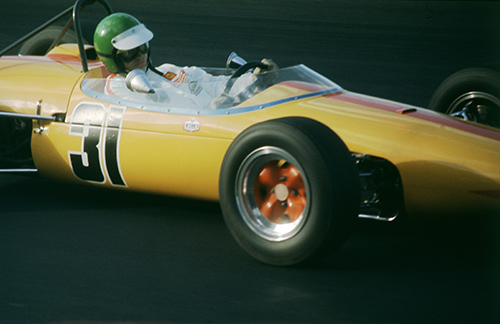
XV Västkustloppet (Rd 6). Reine Wisell (#31), Team Baltzar Racing Team-SMK Motala, Brabham BT18.
(credits Bilsportarvets arkiv)
The one who once again proved to be an 'inconvenience' to the trio was Ronnie Peterson, breaking the hegemony of the championship leaders and managing to secure the second starting position on the grid.
Exceeding the organisers' own expectations, almost 40,000 people attended the XV Västkustloppet, the race that could bring Reine Wisell one step closer to winning the 1967 Svenska F3-Mästerskapet title. But the driver certainly wouldn't have an easy task, as was soon proven.
Right at the beginning of the race, Reine and Kottulinsky tried to revive the scheme that had worked so well at the beginning of the season – first it was important to get ahead of the pack, and then both would duel for the lead. And when this personal skirmish started, it seemed like it would never end.
The two drivers constantly changed positions, taking advantage of the numerous overtaking opportunities that the track provided. What's more, with two different driving styles in play, each driver used every tiny part of the track to their own advantage.
Further back, an increasingly confident Ronnie Peterson held off pressure from Lars Lindberg, who now saw his chances of fighting for the title disappearing in the horizon. But the driver's hope was rekindled when Ronnie's car began to lose speed in the second half of the race.
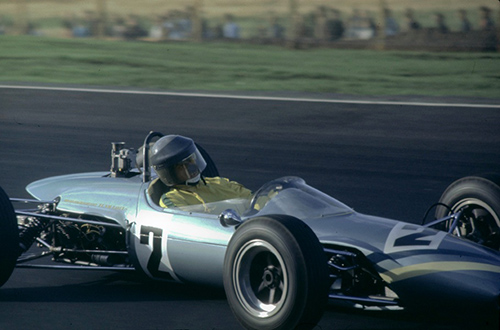
XV Västkustloppet (Rd 6). Freddy Kottulinsky (#2), Haj-Haj Racing Team-Botkyrka MK, Lotus 41C.
(credits Bilsportarvets arkiv)
And the real drama of the race was reserved for the final laps: Ronnie was getting slower and slower on the track and, with just over a lap to go, Lars Lindberg finally managed to take third place. But it didn't last long, as Lindberg made a terrible mistake on the last lap, losing precious time in the race.
This allowed Ronnie to approach, retaking third position a few corners away from the end of the race. And so it was, with the driver crossing the finish line in his dying Brabham with just 8 tenths of an advantage over Lindberg. This was Ronnie Peterson's first podium in F3 – just the first taste of what was to come.
However, nothing compared to what happened in the fight for the lead: on the last lap of the race, Wisell was leading Kottulinsky, with the two competing inch by inch for the lead. ‘Kotten’, in a risky manoeuvre, decided to launch his final attack in the last corner, hoping to catch Wisell at a time when the driver was already preparing to celebrate victory.
At the planned moment, Kottulinsky made his bet: the driver threw his car around the corner, hoping that Wisell would be caught by surprise. But Wisell was already expecting this, and the driver blocked Kottulisnky as soon as he was preparing to execute the manoeuvre. The two cars almost touched, but Wisell was unfazed, and held first position for the final metres of the race. Kottulinsky came second, just a few tenths behind the Brabham driver.
But anyone who thinks that the race ended there is totally mistaken. Shortly after the drivers returned to the pits, Kottulinsky filed a request with the race stewards, alleging that Wisell's manoevre was illegal, stating it as dangerous driving. The request was initially accepted, with Reine being disqualified from the race.
Upon learning of the sentence, it didn't take long for Wisell to take appropriate action, asking for the commissioners' decision to be annulled. After a review, which involved testimonies from those involved and discussions from directors and stewards, the victory was restored to Wisell, with the verdict that the driver's defensive manoeuvre was indeed a legal race move.
Therefore, Reine Wisell now only depended on himself to win the championship. On the other hand, for Kottulinsky, the only thing that would keep his chances of winning the season title alive would be a victory in the last race worth championship points, in Skarpnäck.
RACE 8
Skarpnäcksfältet, Sweden
Stockholmsloppet [I] (August 20th)
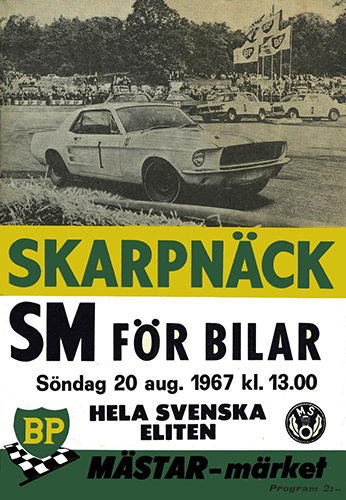
Once again, the airstrip in the suburbs of Stockholm would host the final stage of the Svenska F3-Mästerskapet. Even though the track was not one of the most attractive in terms of the layout itself, providing few overtaking points, its proximity to the capital of the Scandinavian country basically forced, for commercial reasons, the race to be held there.
More important than the race itself, what interested the crowd was the decision of the 1967 title. Reinforcing, it is worth remembering that of the rounds that were eligible for the championship, the four best results achieved by each driver were accounted for in the elaboration of the final ranking. After six races, Reine Wisell led the table with 26 points while just behind, tied in second, were Freddy Kottulinsky and Lars Lindberg, with 22 points each.
The three had mathematical chances of taking home the trophy: Wisell had the shortest path to the title, due to his three victories throughout the season, in addition to his regularity in the other events, which gave him an upper hand, if there was a tie. Both Kottulinsky and Lindberg depended not only on victory in the race, but also on a bad race from Wisell, to have the slightest chance of taking the lead in the table.
Already publicising the race as the grand finale of the season, the organisers soon tried to maximise the quality of the event to the detriment of quantity. Instead of a huge grid made up of more than 20 cars, as was the case in most Svenska F3-Mästerskapet races so far, only 14 were accepted this time for the final. In terms of quality, it is worth noting that of the ten best classified drivers in the championship until the race in Skarpnäck, seven attended the event.
In qualifying practice, it became clear that the battle for the lead would be intense throughout the race weekend. Freddy Kottulinsky was the fastest, demonstrating this time that it would not be Wisell who would call the shots in the Swedish capital. Speaking of him, the championship leader once again carried out consistent qualifying times, once again guaranteeing his place in the top positions. Lars Lindberg, who had not yet given up on fighting for the title, also earned his right to start on the front row.
With the 20th finally appearing on the horizon, it became clear that that Sunday would be ideal for a good race: a classic Nordic day, cold but with few clouds in the sky, which would attract a good crowd to watch the final event of the official Swedish F3 championship.
With 13 cars ready on the grid (the 14th, a Cooper T76 entered by Roland Hedmo, did not arrive in time for the race), the spectacle was ready. And once the flag dropped, the action really started on the circuit. Right at the start, Freddy Kottulinsky suffered a setback when his car got stuck on the starting line, losing several positions to his direct rivals. Reine Wisell was the one who took advantage of 'Kotten's' mistake, thus taking the lead in the race. Behind Wisell were Lars Lindberg and Ronnie Peterson who, for a brief moment, competed for second place.
Seeking to quickly recover from his problem on the first lap, Kottulinsky was already back in contention after a few laps. Halfway through the race, Kottulinsky was threatening Ronnie and Lindberg who were both surprised by the speed of the Lotus driver. Because of this, it didn't take long for both to be overtaken, leaving Kottulinsky free to have a direct duel with Wisell.
While this battle began to take shape, right behind, one of the drivers began to have problems in the race. Soon after completing 14 laps, Ronnie Peterson felt that something was wrong with the car and, without thinking twice, he immediately headed to the pits. The Team Vagabond mechanics were quick to determine that the car had a terminal problem – it was the end of the race for Ronnie.
Even with this retirement, all eyes were now on the fight for the lead of the race and, consequently, the championship. Kottulinsky was 'glued' to Reine Wisell and, what was expected to be a great battle, was decided in a quick and decisive blow. Taking advantage of the Lotus' greater speed, Kottulinsky struck in one of the circuit's long straights and overtook Wisell with impunity.
The Team Baltzar driver didn't even bother giving an answer, simply because Wisell's Brabham wasn't at a level of competitiveness close to the one present in the Lotus that day. Furthermore, Wisell was restricted to following his own pace, as the driver was using tyres that were already worn and reused from other races (and Kottulinsky was using a fresh set).
However, even with the overtake, 'Kotten' was unable to get away from Wisell, with the two running nose to tail until the final flag. Freddy Kottulinsky completed the 20 laps of the race in 20.33.5, just over four tenths ahead of Reine Wisell. Finishing third was Lars Lindberg, giving final numbers to the championship basically dominated by the three drivers.
Kottulinsky's first place at Skarpnäck, however, was nothing more than a pyrrhic victory. Despite equaling Wisell's championship score (26 points), it was the Team Baltzar driver and his Brabham-Novamotor BT18 who were crowned the 1967 Svenska F3-Mästerskapet champions, due to their best overall results of the season.
Reine Wisell, with his three victories of the season (in Skarpnäck, Karlskoga and Falkenberg), now had the right to be considered one of the best drivers in the Nordic countries in single-seater motorsport. This was undoubtedly the first step in a career that still had a lot to grow.
RACE 9 (NC RACE)
Ring Knutstorp, Sweden
III Knutstorp Cup (August 27th)
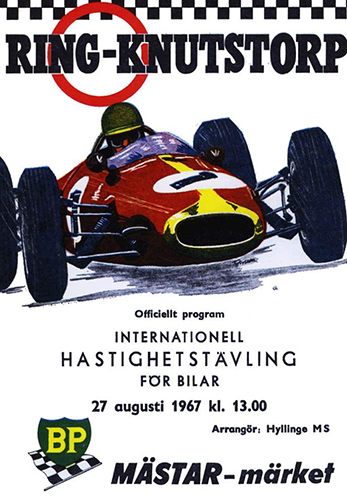
Even though the official Svenska F3-Mästerskapet had ended at Skarpnäck, this did not mean that the country's racing calendar had concluded. On the contrary, two other stages were still scheduled before the thoughts shifted to 1968. The first of them would take place at Knutstorp, almost four months after the F3 cars first visited the track.
As it was another event with a semi-international status, it didn't take long for a long list of interested parties began to pop-up in organisers hands. In the end, 44 drivers from nine nationalities signed up for the race, with a huge array of machines and talents. Due to withdrawals, which always happened before the start of the qualifying sessions, this number was reduced to 32.
To filter the number of drivers in the races as much as possible, it was decided that the event would be held in an elimination heat scheme, which would define those classified for the final race. First, the 32 cars would be split into 2 groups, with each having to complete a heat of 16 laps – the final position was not the most important thing in these races, since the classification factor used was time. Because of that, the 20 drivers who were quickest to complete the laps would qualify for the final race, contested over another 20 laps.
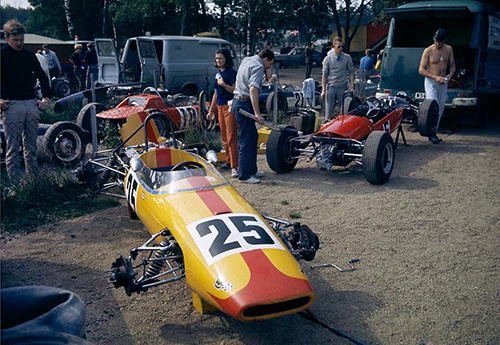
Behind the scenes at the III Knutstorp Cup. In the foreground, Reine Wisell's unmistakable red-yellow Brabham. The car being removed from the truck is Curth-Rune Johansson's Brabham BT18. (credits Bilsportarvets arkiv)
All the highlights of the Swedish season signaled positively to the race: the recently crowned champion Reine Wisell, his runner-up, Freddy Kottulinsky, as well as Lars Lindberg, Ronnie Peterson and Ulf Svensson. In addition, other well-known names also headed towards the Knutstorp circuit, such as South African Trevor Blokdyk, who would drive an official Pygmée MDB67 from the French manufacturer, and New Zealander Howden Ganley who, with a Brabham BT21, was still taking his first steps in international motorsport.
The first heat would be Kottulisnky's first chance to give payback to Wisell, after the latter's title in the championship, as they were both scheduled for the same heat. And 'Kotten' gave the message to the champion, when the Sportsvagnsimporten AB/Team Lotus driver won this first confrontation, two seconds ahead of second-placed Wisell. Briton Mike Keens finished third, driving a Brabham BT21 modified by P & M Racing Preparations. Lars Lindberg, who was also drawn for this heat, finished in a poor seventh place – which was just enough to qualify him for the final.
In the second heat, it was Ronnie Peterson's turn to give his own private show, when the driver simply destroyed the opposition. Starting behind Ulf Svensson, the Team Vagabond driver soon took first place; and, when the driver crossed the finish line for the last time in the heat, Ronnie was already more than six seconds ahead of Ulf Svensson, who had become his closest pursuer. It is worth remembering that the Knutstorp circuit was only 1100m long at the time – therefore, opening up such an advantage on such a short and winding circuit was a fact that in itself attested to Peterson's talent.
Taking into account the final composition of the grid for the final race of the day, it was no surprise that the main race was eagerly awaited. With the front row occupied by Kottulinsky, Wisell and Peterson, anything could happen in the first few metres.
The flag was dropped and the cars zipped down the small Knutstorp main straight. At the end of the first lap, it was Ronnie Peterson who was leading, followed by Kottulinsky and Wisell. Peterson soon tried to open up an advantage to his two pursuers, leaving Wisell and Kottulinsky to resolve their differences alone. The point is that it was Kottulinsky who paid more attention to the confrontation, since Wisell's objectives were to escape direct combat with 'Kotten' and go after Peterson's first position.
Behind the first group, a multinational fight was forming between the South African Blokdyk, the Briton Keens and the Swede Svensson. The Swede initially tried to attack his competitors, but soon ended up falling a little behind in the confrontation. However, Blokdyk was more successful in his offensive, managing to take fourth place from Keens.
Returning to the duel between Wisell and Kottulinsky, the battle finally reached its climax: in one of the bends, Kottulinsky missed his breaking point and consequently the apex. The road was clear for Wisell, who took second place and was now chasing Peterson.
Lap after lap, Wisell began to reduce the gap between him and Ronnie, even setting a lap record of 41.1. With just under five laps to go, Wisell was in Ronnie Peterson's wake, calculating the right time for the final attack. And this would happen on the last lap, when once again, Wisell took advantage of a moment of neglect of one of his opponents.
Reine Wisell had proven that he was the face of the Swedish season so far, recording his fourth triumph in the country in 1967. Peterson, who had once again seen victory slip through his fingers, had finished in an excellent second place – even though it wasn't the expected result, this would undoubtedly be a boost in the driver's confidence. Kottulinsky, who only held back in the final laps, saw the confrontation between Wisell and Peterson from a privileged position. 'Kotten' completed the race in the final position on the podium.
RACE 10 (NC RACE)
Skarpnäcksfältet, Sweden
XVII Stockholmsloppet [II] (September 24th)
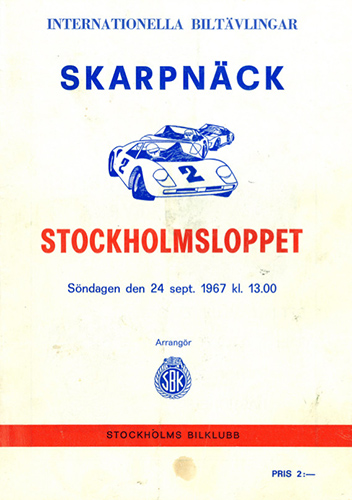
Now it was time for the final act of the 1967 Swedish F3 season. For the third time in the year, the Skarpnäck airfield would host a race, which this time would have very different contours to those of the other nine stages. The XVII Stockholmsloppet was expected to close the year with a flourish, as the race generally attracted good international attention, as it is one of the most coveted events in the Nordic countries. But in a rare mistake made by Swedish organisers, the date chosen for the race was the worst possible. On the same weekend that Stockholmsloppet would take place, two other F3 races were happening simultaneously: the traditional Coupe de Vitesse, in Albi and the Danmarksmesterskab, in Djurslandring.
Even though Stockholmsloppet had a higher level of prestige than both races, a decisive factor in attracting the best drivers was always the financial return. Both Albi and Djursland would offer a prize pool almost three times greater than that offered in Skarpnäck; it is therefore no surprise that, in a category like F3, where the commodity 'money' was scarce, the drivers choose to race in the events that paid the most.
Even so, some drivers chose for the prestige of the trophy rather than the money. To this end, some good names headed to Sweden: in addition to Howden Ganley and Mike Keens, who decided to return to the country after their experience in Knutstorp in August, Gijs van Lennep, Mike Beckwith and Dave Walker packed their bags and left for the Swedish capital circuit.
The main highlights were undoubtedly Van Lennep and Beckwith, who were part of The Checkered Flag, one of the strongest and most consolidated teams on the F3 scene at the time. From 1966 onwards, the team used cars built by Dutch company DAF, which were nothing more than licensed copies of the Brabhams F3. For 1967, the DAF/Gemini model was based on the British manufacturer's BT21 chassis, but the similarities ended there.
Since the DAFs were built solely and exclusively for The Checkered Flag, it was expected that there would be differences compared to other mass-built F3s. The engines appeared to be the same Cosworths built for Brabhams, but in fact, they were modified versions, tuned by DAF itself in partnership with British engineer Charles Lucas.
Furthermore, the cars used a system of continuously variable transmission (CVT), also known as Variomatic. As opposed to the traditional Hewland transmission, used by 99% of F3 cars and which applied the traditional gearbox changing gear system, the Variomatic used a fixed gear system, which promised to minimise the loss of energy and performance during the process of changing gears.
If the foreign presences attracted some attention, the disappointment was on the home drivers. Of the season's top-5, only Lars Lindberg and Ronnie Peterson attended the event. Reine Wisell chose to compete in the race in France, while Kottulinsky and Svensson went to Denmark.
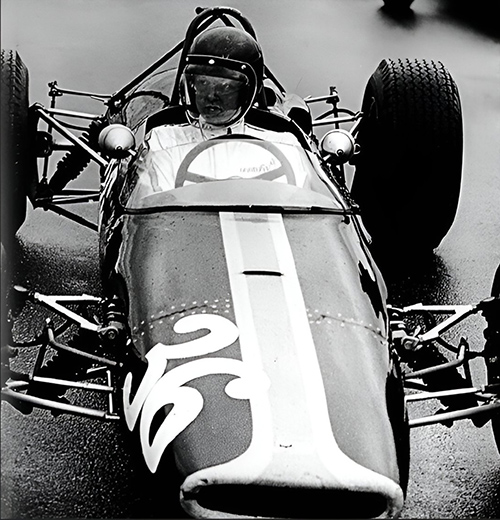
Ronnie Peterson gets ready for the last round of the season, the Stockholmsloppet. (credits Rickard O. Lindström)
In the end, 16 cars appeared in the paddock before the timing sessions began. The Skarpnäck circuit was wet, due to incessant rain that had been falling in the Swedish capital for a few days. By some force majèure, however, the rain had stopped just as the cars began to enter the track.
The one who stood out was Mike Beckwith, who quickly demonstrated that the DAFs would be a headache for the local drivers. The driver set the fastest time in training, with a lap of 1.04.7. The driver who would start second would be Ronnie Peterson, suggesting that the Swedish drivers would not be so easily surpassed by their foreign contemporaries.
Sharing the second row were the Finn Curt Lincoln (Brabham-Holbay BT21) and another Swede, Ove Niklasson (Lotus-Holbay 35 – this exact car, chassis number 35-F-17, was an ex-Kottulinsky car with which the driver won the 1966 Svenska F3-Mästerskapet). Right behind, were Lars Lindberg and Gijs van Lennep.
With the cold as an omnipresent companion, more than 6000 people turned out to see the final race of the year in Sweden the following day. Without any unexpected events, all 16 cars lined up on the grid, waiting for the official flag. And when it arrived, it was Gijs van Lennep who made the most of the first metres of the race, overtaking all five drivers in front of him and taking first place. Following closely behind were Beckwith, Lincoln, Ronnie, Niklasson and Lindberg.
Van Lennep quickly began to pull away from his pursuers, leaving the other five cars to compete for the final two spots on the podium. Beckwith tried to follow his teammate's pace, but Curt Lincoln wouldn't let the driver escape. Ronnie Peterson, who was following the Finnish driver closely, tried his best to take third position, but Lincoln and his Brabham defended the position in an exemplary manner.
After five laps, Ronnie was now starting to worry more about defense than attack, after Lars Lindberg took fifth place from Niklasson. Lindberg was at a much better pace than his opponent, managing to overtake Ronnie just four laps later.
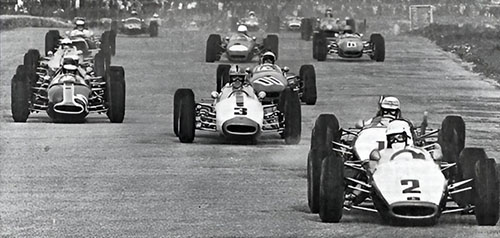
The II Stockholmsloppet, a non-championship race, was won by Gijs van Lennep, in a DAF F3.
(credits Rickard O. Lindström)
On lap 11, Mike Beckwith, who was now well established in second place, had a terminal problem with his DAF, after the car had a failure in the fuel supply system. Thus, Lincoln was now in second place, with a fast Lindberg in third.
The laps followed one another, without any major changes in the classification. Gijs van Lennep continued to open up an advantage, while Lincoln and Lindberg were in a private skirmish. Ronnie had already accepted his fate of being in fourth place.
But the Swedes had a stroke of luck two laps to the end, when Lincoln's Brabham twisted its driveshaft, mortally weakening the Finn's car. Without having much to do, the driver could only drive his crippled machine to an escape area on the circuit, retiring from the race just a few moments from the end.
And so was the final act of the 1967 F3 season in Sweden. Gijs van Lennep was the first driver to complete 20 laps, with a time of 19.48.5, almost 20 seconds ahead of second-placed Lars Lindberg. An unexpected and welcomed third place landed in Ronnie's lap, with his brave Brabham BT18.
What was seen in this September race was the gap that still existed between regional and international F3 competitions. For example, Van Lennep's record lap at the international Skarpnäck meeting was three seconds faster than those achieved in the regular season of the Svenska-Mästerskapet.
Furthermore, it is very likely that if it weren't for the problems of Mike Beckwith and Curt Lincoln, no Swede would have finished the race on the podium. But this was a problem that could be corrected, with increasingly bold and talented drivers, such as Reine Wisell and Ronnie Peterson, who attracted more and more interest and technology to the foundations of Nordic motorsport.
Why to read me?
For reasons and motives that we cannot explain, it seems that from time to time the stars seem to align in one random spot, and some country in the world begins to produce a new crop of excellent drivers. In the fifties, we had the spectacular Argentine generation, with Fangio, Gonzalez, Galvez and Menditeguy, and the Italian one, with Ascari, Farina, Villoresi and Musso. In the sixties, it was time for the British Isles to rule, with Clark, Hill, Surtees and Stewart fighting memorable battles with the 'Down-Unders' such as Brabham, McLaren, Amon and Hulme.
The turn from the sixties to the seventies saw several countries generate their own breeds, such as Germany (Rolf Stommelen and Jochen Mass), France (J.P. Beltoise, Henri Pescarolo, Patrick Depailler and François Cevert) and Brazil (the Fittipaldi brothers and Carlos Pace). Sweden managed to be part of this movement, at a time when the Nordic countries had little tradition in closed circuits.
Both Reine Wisell and Ronnie Peterson (as well Jo Bonnier, a decade earlier than the duo) were pioneers in the Nordic countries in introducing this type of high-performance sport in the region. The first steps taken by them not only in Formula 1, a category that will forever be linked to the image of the duo, but also in F2 and F3, were extremely important in this development process.
It's worth thinking that perhaps if it weren't for them, we wouldn't have seen other drivers from the Nordic region in F1 in the following years, such as the Dane Tom Belsø, who drove for Williams in 1973, or the Finn Leo Kinnunen, who for the AAW Racing Team (which marked another major milestone, being the first Nordic F1 team) contested the 1974 championship.
Even though the performance of the latter fell well short of that achieved by their Swedish counterparts, these were still evolutionary steps. Learning through the successes and failures of past generations is key to any goals we have in the future. This is also the case with motorsport.
Acknowledgments
:- Illustrerad Motor Sport Magazine (Sweden): editions from March to October 1967
- Facebook page Racing Nostalgi Sverige
- Facebook page Ronnie Peterson Tribute
- Website Bilsportarvets arkiv - The Swedish Automobile Sport Heritage
- Website The Fastlane, F3 1967 sub-section
- Website The Programme Covers Project, year 1967
- Website Racepace, Swedish racing sub-section
- Website of Rickard O. Lindström
